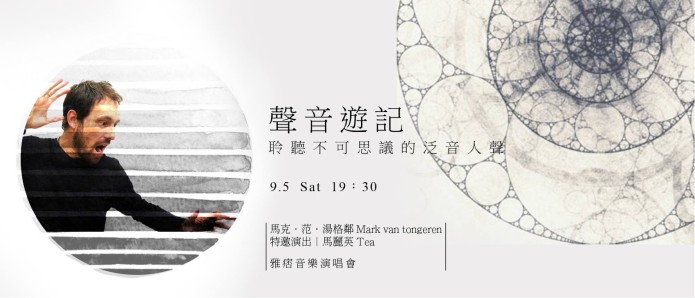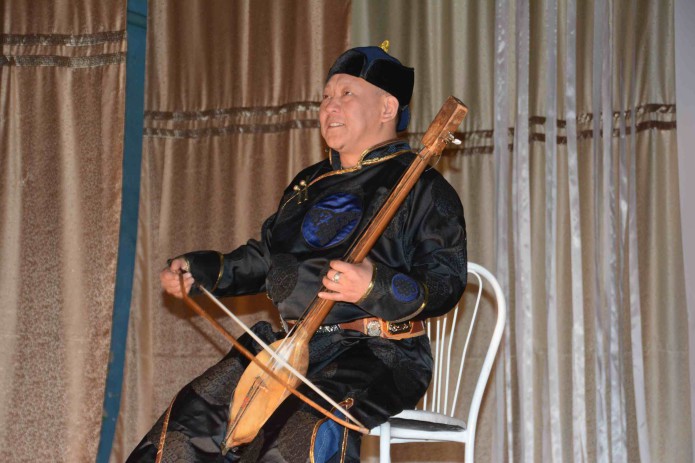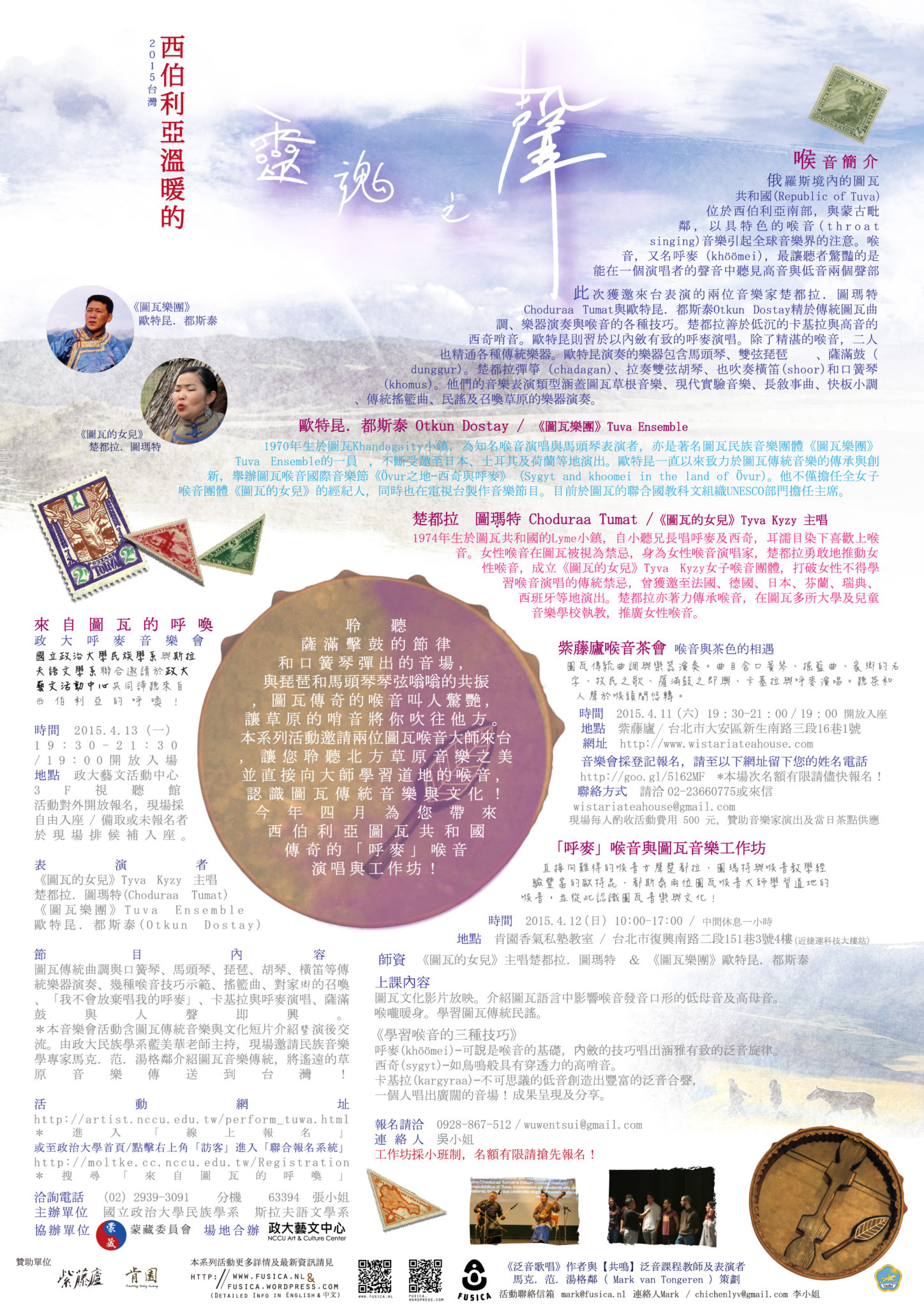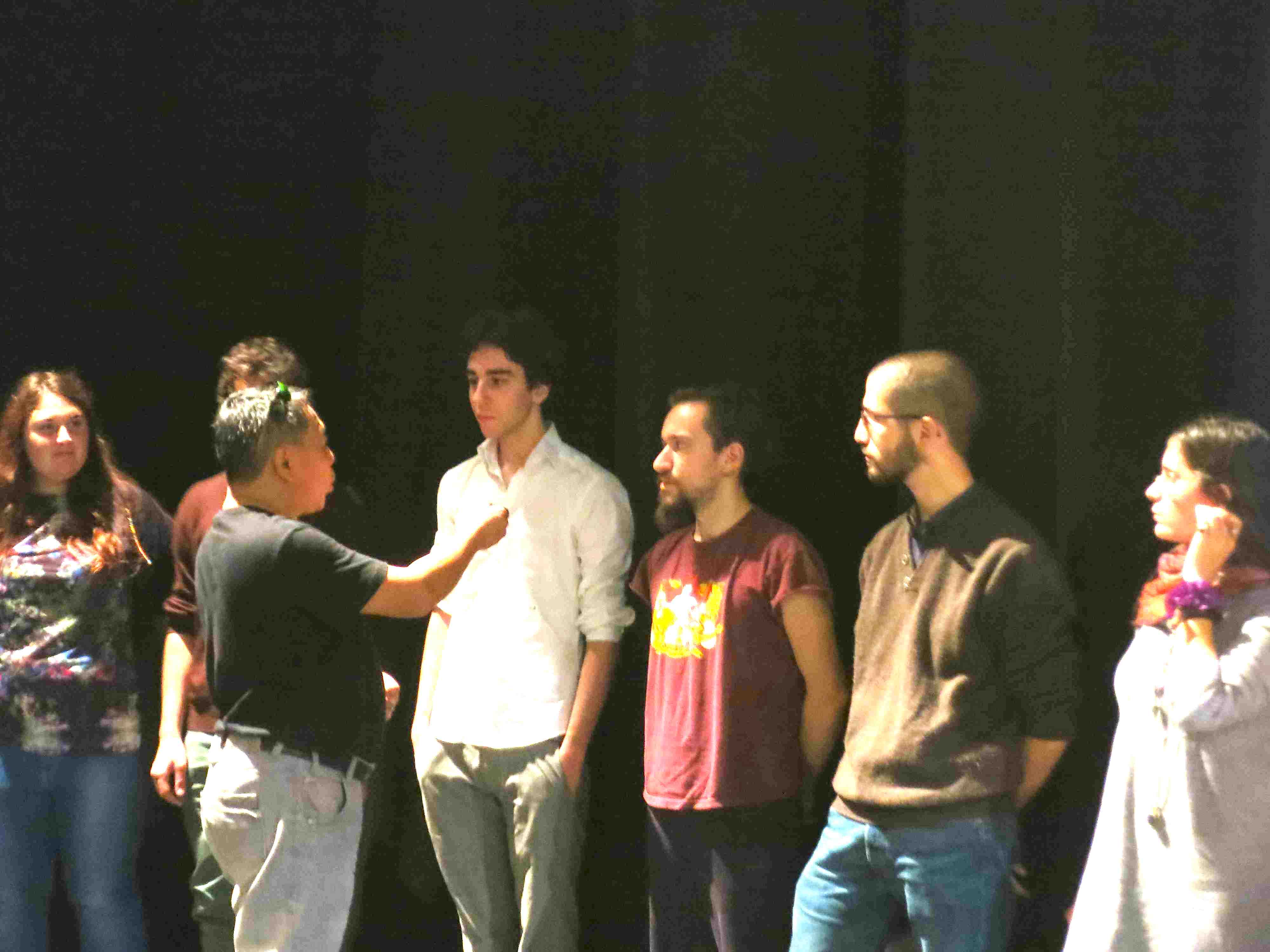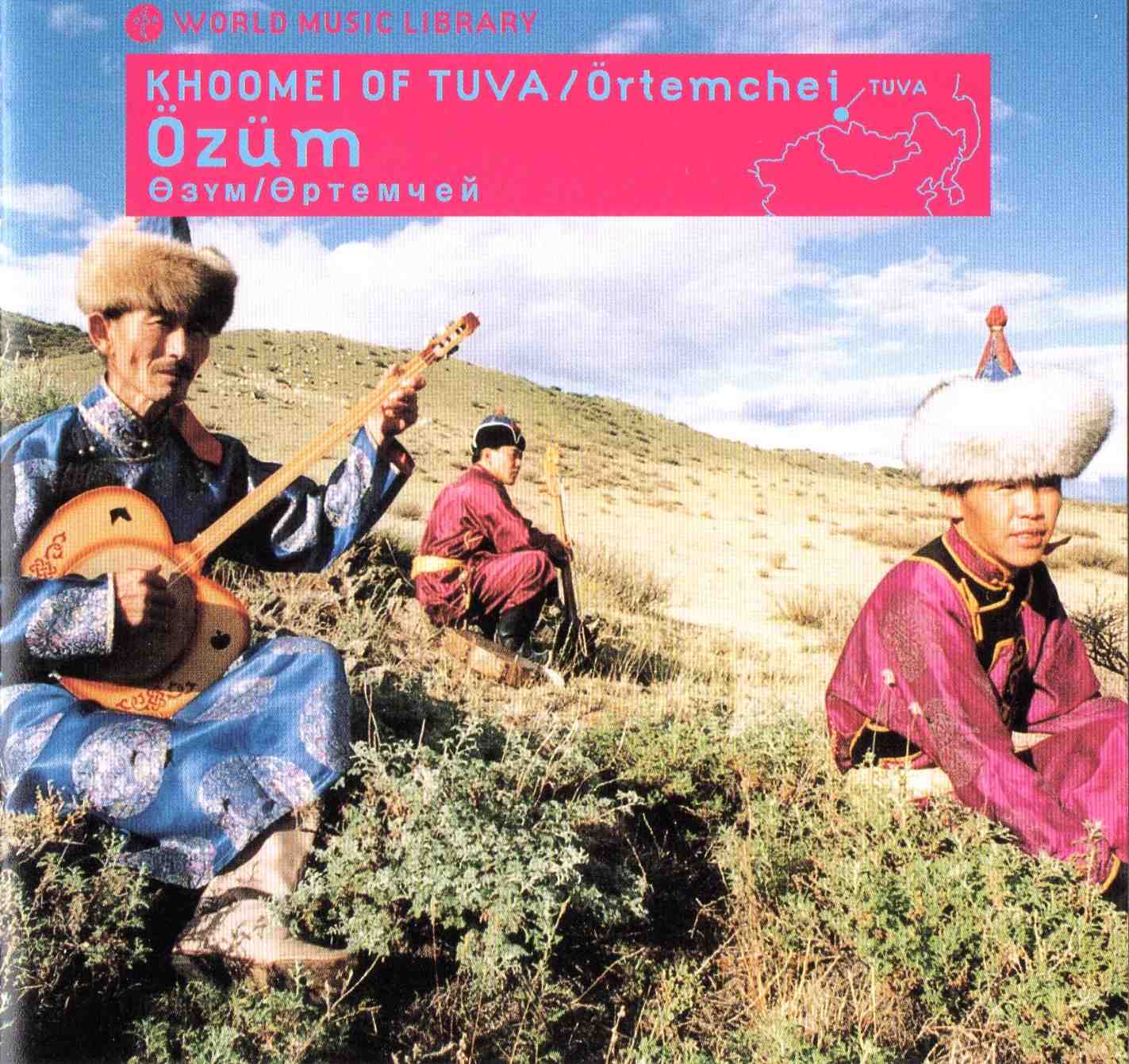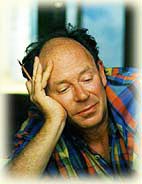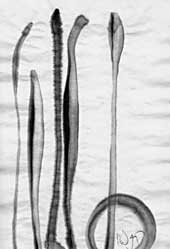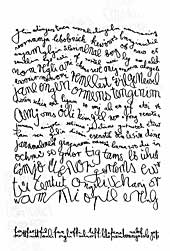2-day workshop Outer Sound
Overtone Singing
Sept 5: Sound Travels concert
This Saturday evening (September 5, 19:30, at Yuppy Cafe/Bookstore) I’ll be doing a concert of songs I have learned from oral traditions of various places around the globe. Tea (Tina Ma) is going to help create some links between them in her own magical way. After that, I will sing together with the audience and give an idea what we do in the R e s o n a n c e course.
For me this is a real first, to sing ‘plain’ traditional songs: I have never quite thought of myself as a ‘traditional singer’ of any kind and only reluctantly began to sing Tuvan khöömei (throat singing or overtone singing) when I was asked to. I developed an interest in singing Dutch songs at the time my son and daughter were born. Since then (and maybe because of that) I have changed my attitude towards traditional music. I slowly started to learn more songs in traditional ways, instead of ‘appropriating’ other music for my own musical language. I am now learning and singing songs from Tuva, Corsica, The Netherlands and other places for some years, and feel ready to present them onstage.
I began travelling to collect and learn music in 1990, when I visited Bulgaria. Then to Corsica in 1991. Then Russia in 1992, which was the upbeat for Siberia in 1993, where I went back several times. In the 2000s I visited New Zealand, Dharamsala, Jerusalem and Sardinia, amongst other places, and began moving to Taiwan. All the while I also met many travelling and migrant musicians, learning from or with them from time to time.
This Summer I visited Turkey and had an opportunity to learn a song from a well-known Turkish folk singer, Aysegül Aral. I was curious to learn more about singing with the quartertones you can find in Turkish and Arabic music, and I was happy to find I was doing alright, according to my instructor Aysegül. The song we sang (and which I will perform Saturday) is called Havada bulut yok, a well-known folk song.


Aysegul Aral, the interpreter and me
Another special meeting several years ago was with Firaz Ghazzaz, a muslim reciter for the Palestine community of Eastern Jeruzalem. We collaborated in a project by two Dutch composers, Merlijn Twaalfhoven and Paul Oomen, helping to give voice to the suppressed communities of Palestines in Jerusalem. Firaz is the descendent of a long line of reciters for the Al Aqsa Mosque (going back for as much as 422 years when I visited). Al Aqsa is one of the most important mosques in the Arab world, situated on holy, historic territory in Jerusalem. I was struck by the humanity and the willingness to improvise, leaving his religious tradition behind to look for common ground in my improvised, coloristic, harmonic language and his own modal chanting. There is tremendous power and refinement in his singing, as you can hear in Firaz’ collaboration with another musician from Europe here.
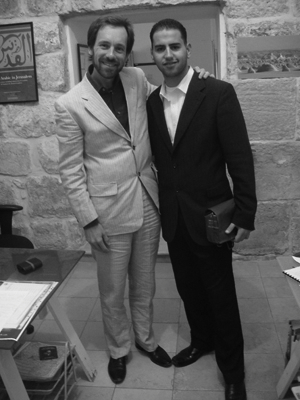

With Firaz Ghazzaz, 2009
In Corsica, the French isle, you can hear echoes of this kind of intonation, though very distant ones. In this case they stem from the need for voices to harmonise according to pure, Pythagorean intonation, and not because of a modal tuning system as developed by the Arabs. In recent years, when I re-visited Corsica, I had many opportunities to immerse myself in polyphonic singing, and take part in it. Now I feel ready to sing some Corsican songs, but of course there will be no polyphony this Saturday (though I am considering to teach the audience a simple line so we get two parts). This year I joined the concert of musicians from Pigna: Nando Aquaviva and his daughter Battista, and Cecce Pesce, the guitarist. When we first met, Battista was beginning to be famous in Corsica. This Summer, she suddenly was famous all over France due to her appearance in the popular TV show The Voice.
In 2013 I sang some ‘alle-male’ polyphony with Claude Bellagamba, a middle-aged singer with an exceptional, powerful and natural voice, and Nando, who is past his prime years (he is 70+) but still getting along well and very active musically.


Claude Bellagamba, Nando Aquaviva and me singing polyphonic songs, Corsica 2013
Of course there will be music from Tuva, Siberia. Choduraa Tumat and Otkun Dostay, who came over from Tuva to perform in Taiwan this spring, helped me with the lyrics of a well-known song by the folk singer/composer Maksim Dakpai. In their concerts we did not sing this song, but contemporary and shamanic improvisations with voice and Jew’s harp. I did not quite feel up to singing traditional songs with them onstage: to be honest, I think for singing traditional music you need to know the lyrics by heart, and I am still struggling with that. In that sense my concert this Saturday is not so traditional: I will need the help of written lyrics on a sheet for sight-reading for most of the songs. The ‘shamanic’ improvisation is one possible way out of that problem, but not just second choice. Besides singing Dakpai’s song Saturday, I will also do a shaman-styled improvisation.
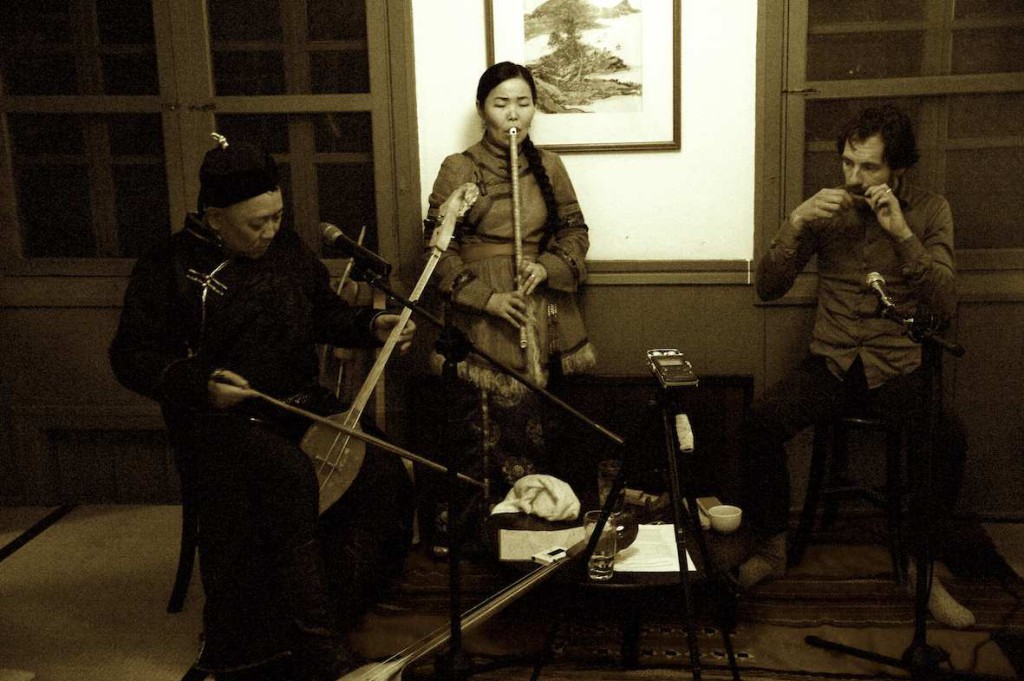

Otkun Dostay, Choduraa Tumat & me at Wistaria Teahouse, 2015 (photo by Ewan Kuo)
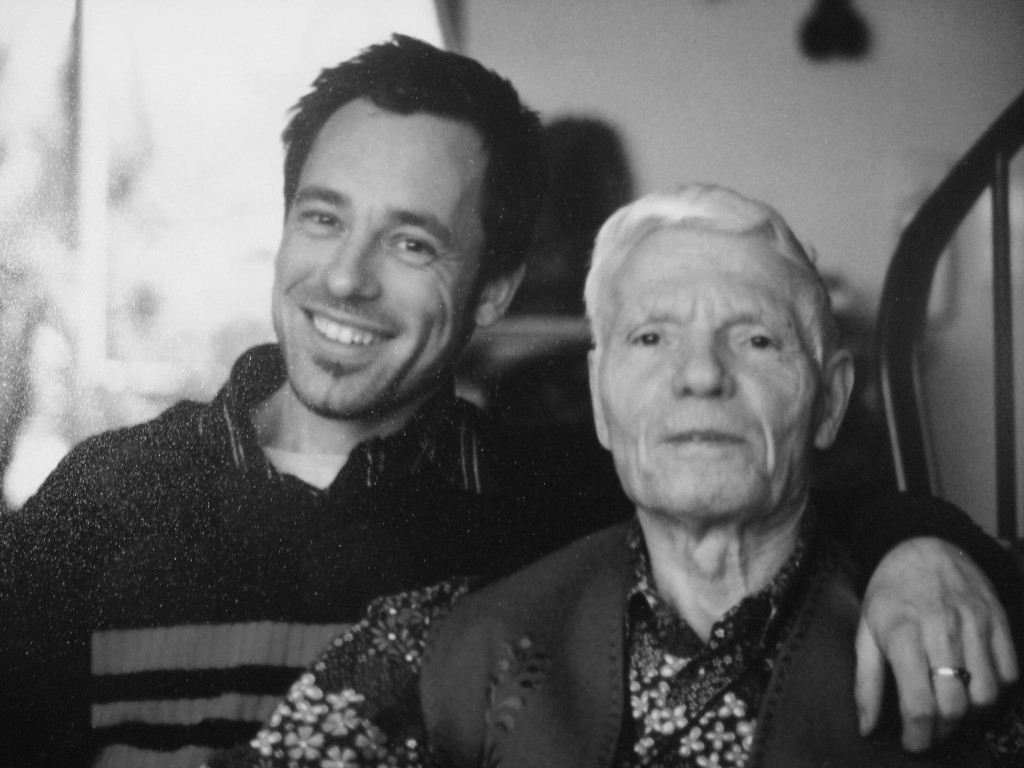

I visited Hungarian shaman and sound practitioner Joska Soos several times in Belgium.
I have spent much time learning a Hakka song, Hakka being one of the Chinese minorities in Taiwan (and China) with a distinct culture and music. I have always liked Hakka music when I heard it on the radio here, but it is not easy to sing it. My kids learnt some Hakka songs at school and I had great difficulty to get the melody right when I asked them to teach me (and how lucky I am with children who have such critical ears at such an early age!). This year I am working on a dance piece with Taipei Dance Circle, founded by Hakka choreographer Liou Shaw-lu. In order to pay tribute to Shaw-lu, who passed away a year ago, we decided to sing a Hakka song for him. The dance performance will première next week in Taipei’s National Theatre (Experimental Theatre), so I take the chance to do a try-out of Lao shan ge at Yuppy Bookstore.
Then there will be an indigenous Taiwanese song and things from Mongolia, India and of course the Netherlands.
Talking about oral traditions, there is Tina ‘Tea’ Ma, or … is she? It is still a little bit of a mystery what she will do, or even that she makes it, immersed as she is in Taiwan’s East Coast indigenous Amis communities. She seems to be forgetting the time in Hualien (we all do when we go there!). I am not even sure she will manage to get out of the spell of the songs and rituals she is learning there. If she makes it, she may turn out to be the most ‘traditional’ or ‘authentic’ of the voices you will hear this Saturday. Let’s hear!
Info and reservations at Yuppy Cafe and Bookstore .


Tina ‘Tea’ Ma with moonlute
Workshop Tuvan Throat Singing (khoomei)
One-day workshop throat singing/Tuvan music and culture. With a male and female throat singer (Otkun Dostay/Choduraa Tumat). Check the blogpost and contact us for more details.
Musical pearls from Tuva in Taiwan


In April two excellent musicians and friends from Tuva are coming to Taiwan, so that people here can get better acquainted with this fascinating musical culture from the North. Get to know Tuvan music and culture and learn throat singing directly from established, original masters!
be amazed by Tuva’s signature sounds of throat singing
hear the beats of the shaman drum and Jew’s harp
resonate with the buzzing strings of horse-head fiddles and lute
get blown away by flutes from the steppe
THE PROGRAM FROM APRIL 11 TO 13
Saturday April 11, 19:30 Concert Pearls from Siberia, at Wistaria Teahouse.
Donation-based. Very limited seats!


As a donation we suggest 500 NT$ for the perfomance, tea and a snack. Call Wistaria and leave your name and number for a seat: (02)2363-7375 or register here.
This event is sponsored by Wistaria.
Sunday April 12, 10-17 1-day workshop Tuvan throat singing and culture, at Canjune Training Center
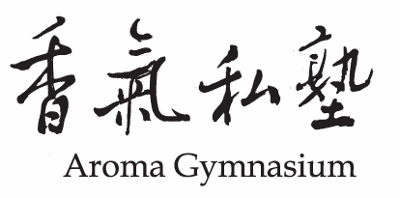

We aim at a 50/50 divide of male/female voices. The workshop is held in English/Russian with Chinese translation. Mark will be there to help translate Russian-English, if needed.
If you are interested and want to reserve a place, you can call or write Mark (mark@fusica.nl, 0910382749) or Wu Wentsui (wuwentsui@gmail.com, 0928867512).
This event is sponsored by Canjune.
Monday April 13, 19:30-21:30 Concert Tuvan music and culture. National Chengchi University, Arts and Culture Center, Audiovisual Theatre
![]()
![]()


This event is sponsored by the Mongolian and Tibetan Affairs Commission in Taiwan.
THE MUSICIANS
Otkun Dostay
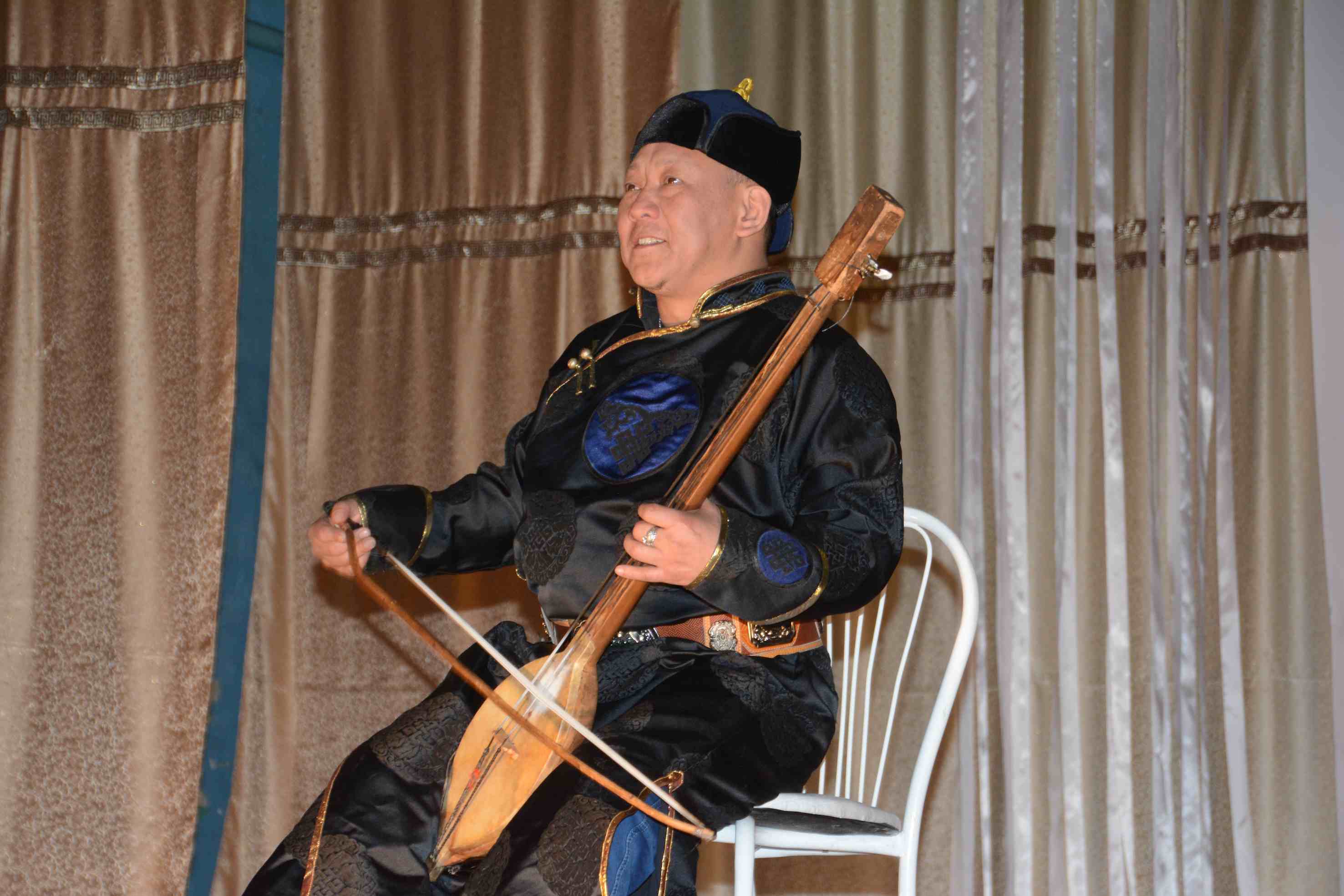

Choduraa Tumat
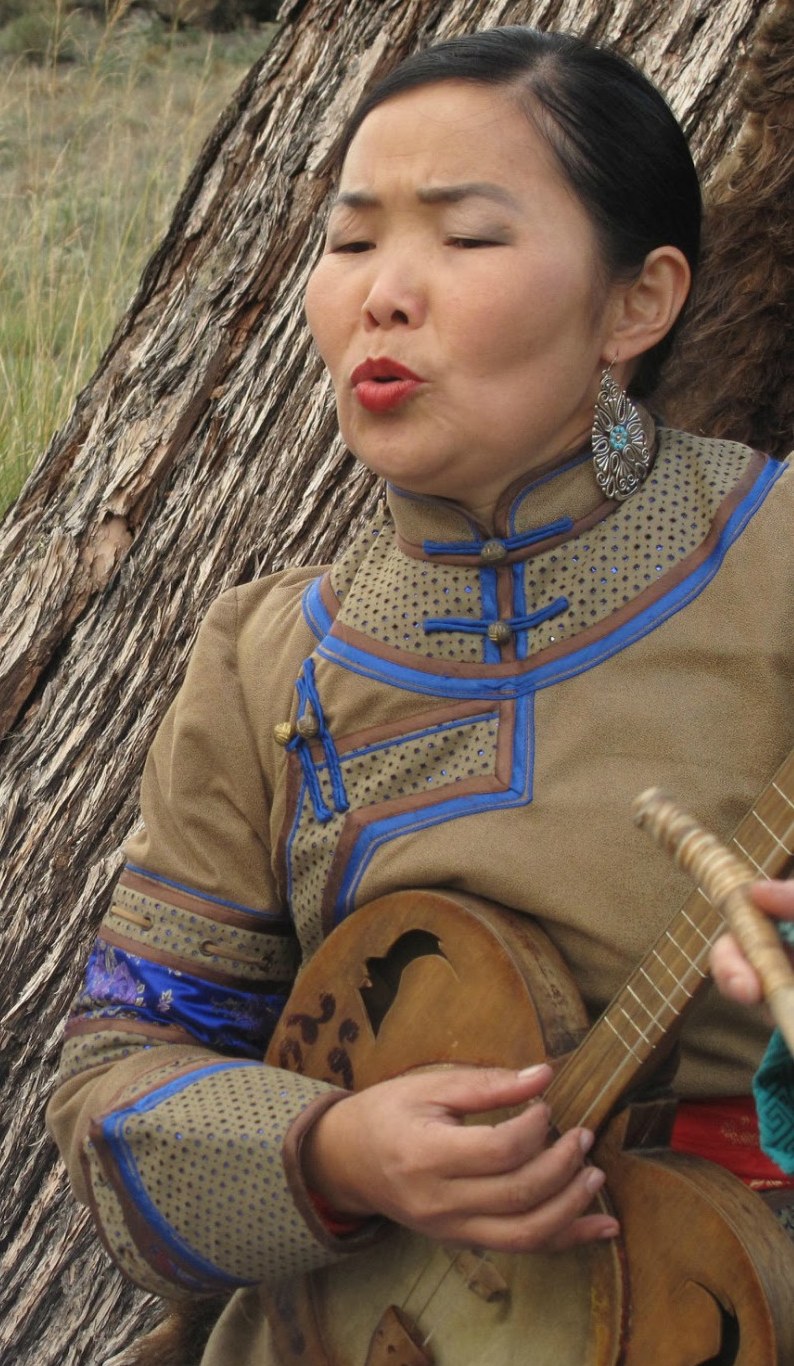

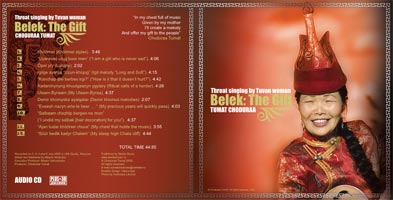

《西伯利亞溫暖的靈魂之聲》2015 台灣
聆聽薩滿擊鼓的節律和口簧琴彈出的音場
與琵琶和馬頭琴琴弦嗡嗡的共振
圖瓦傳奇的喉音叫人驚艷
讓草原的哨音將你吹往他方
本系列活動邀請兩位圖瓦喉音大師來台,讓您聆聽北方草原音樂之美並直接向大師學習道地的喉音,認識圖瓦傳統音樂與文化!
《圖瓦的女兒》Tyva Kyzy 主唱楚都拉.圖瑪特 (Chodurra Tumat)
《圖瓦樂團》Tuva Ensemble 歐特昆.都斯泰(Otkun Dostay)
今年四月為您帶來西伯利亞圖瓦共和國傳奇的「呼麥」喉音演唱與工作坊
《泛音歌唱》Overtone Singing作者與【共鳴】泛音課程教師及表演者Mark van Tongeren 馬克.范.湯格鄰策劃
本系列活動更多詳情及最新資訊請見:www.fusica.nl ; https://fusica.wordpress.com
活動聯絡信箱:mark@fusica.nl 連絡人 Mark / chichenlyv@gmail.com 李小姐
【喉音簡介】
俄羅斯境內的圖瓦共和國(Republic of Tuva)位於西伯利亞南部,與蒙語毗鄰,以具特色的喉音(throat singing)音樂引起全球音樂界的注意。著名的音樂家Sainkho Namtchylak就曾多次到台灣演出,以圖瓦音樂吟唱與爵士樂、電子樂等前衛即興音樂結合,讓台灣聽眾認識圖瓦傳統音樂的多樣性。
喉音,又名呼麥(khoomei),最讓聽者驚豔的是能在一個演唱者的聲音中聽見高音與低音兩個聲部。圖瓦的喉音伴隨傳統樂器馬頭琴(igil)、琵琶(doshpuluur)、胡琴(byzaanchy)等,將圖瓦傳統音樂流傳至世界各地。
圖瓦喉音大致區分為以下幾種,包括khoomei(呼麥)、kargyraa(卡基拉)、sygyt(西奇)、chylandyk(蟋蟀鳴聲)、dumchuktaar(鼻音卡基拉)、ezengileer(馬鐙式唱法)、borbangnadyr(流水滾動音)等。此次獲邀來台表演的兩位音樂家楚都拉.圖瑪特Choduraa Tumat與歐特昆.都斯泰Otkun Dostay精於傳統圖瓦曲調、樂器演奏與喉音的各種技巧。楚都拉善於低沉的卡基拉與高音的西奇哨音。歐特昆則習於以內斂有致的呼麥演唱。
除了精湛的喉音,二人也精通各種傳統樂器。歐特昆演奏的樂器包含馬頭琴、雙弦琵琶 、薩滿鼓(dunggur)。楚都拉彈箏(chadagan)、拉奏雙弦胡琴、也吹奏橫笛(shoor)和口簧琴(khomus)。他們的音樂表演類型涵蓋圖瓦草根音樂、現代實驗音樂、長敘事曲、快板小調、傳統搖籃曲、民謠及召喚草原的樂器演奏。
【音樂家介紹】
Choduraa Tumat 楚都拉.圖瑪特
《圖瓦的女兒》女子喉音團體的團長楚都拉,1974年生於圖瓦共和國的Lyme小鎮,自小聽兄長唱呼麥及西奇,耳濡目染下喜歡上喉音。 女性喉音在圖瓦被視為禁忌,身為女性喉音演唱家,楚都拉勇敢地推動女性喉音,成立《圖瓦的女兒》女子喉音團體打破女性不得學習喉音演唱的傳統禁忌 。楚都拉為圖瓦的全才型藝術家,精通喉音中的各種技巧如繞富韻致的呼麥、低沉的卡基拉、高繞的西奇哨音、和如騎馬般充滿節律性的馬鐙唱法 ,曾獲邀至法國、德國、日本、芬蘭、瑞典、西班牙等地演出。楚都拉亦著力傳承喉音,在圖瓦多所大學及兒童音樂學校執教,推廣女性喉音。
Otkun Dostay 歐特昆.都斯泰
1970年生於圖瓦Khandagaity小鎮,為知名喉音演唱與馬頭琴表演者,亦是著名圖瓦民族音樂團體《圖瓦樂團》Tuva Ensemble的一員,於音樂上有卓越的成就,不斷受邀至日本、土耳其及荷蘭等地演出。歐特昆一直以來致力於圖瓦傳統音樂的傳承與創新,舉辦圖瓦喉音國際音樂節《Övur之地—西奇與呼麥》(Sygyt and khoomei in the land of Övur)。他不僅擔任全女子喉音團體《圖瓦的女兒》的經紀人,同時也在電視台製作音樂節目,極力推廣傳統音樂。目前於圖瓦的聯合國教科文組織UNESCO部門擔任主席。
紫藤廬喉音茶會
喉音與茶色的相遇
圖瓦傳統曲調與樂器演奏。曲目含口簧琴、搖籃曲、家鄉的名字、牧民之歌、薩滿鼓之即興、卡基拉與呼麥演唱。聽茶和人聲於喉頭間悠轉。
時間:2015.4.11 (週六)19:30-21:00(19:00 開放觀眾入座)
地點:紫藤廬(台北市大安區新生南路三段16巷1號)
音樂會採登記報名:請電洽紫藤廬(02)2363-7375 留下您的姓名電話完成報名
*本場次名額有限請儘快報名!
現場每人酌收活動費用 500 元,贊助音樂家演出及當日茶點供應。
贊助單位:紫籐廬
網址:http://www.wistariateahouse.com
「呼麥」喉音與圖瓦音樂工作坊
直接向難得的喉音女聲楚都拉.圖瑪特與喉音教學經驗豐富的歐特昆.都斯泰兩位圖瓦喉音大師學習道地的喉音,並從此認識圖瓦音樂與文化!
【上課內容】
圖瓦文化影片放映。介紹圖瓦語言中影響喉音發音口形的低母音及高母音。喉嚨暖身。學習圖瓦傳統民謠。
《學習喉音的三種技巧》
呼麥(khöömei)—可說是喉音的基礎,內斂的技巧唱出涵雅有致的泛音旋律。
西奇(sygyt)—如鳥鳴般具有穿透力的高哨音。
卡基拉(kargyraa)—不可思議的低音創造出豐富的泛音合聲,一個人唱出廣闊的音場!
成果呈現及分享。
【師資】
《圖瓦的女兒》Tyva Kyzy 主唱楚都拉.圖瑪特 (Choduraa Tumat)
《圖瓦樂團》Tuva Ensemble 歐特昆.都斯泰(Otkun Dostay)
時間:2015.4.12(週日)10:00-17:00 (中間一小時休息)
地點:肯園香氣私塾教室(台北市復興南路二段151巷3號4樓)*近捷運「科技大樓」站
報名請洽:0928-867-512 / wuwentsui@gmail.com 連絡人:吳小姐
工作坊採小班制,名額有限請搶先報名!
課程更多詳情及最新消息公佈請見:www.fusica.nl ; https://fusica.wordpress.com
來自圖瓦的呼喚
政大呼麥音樂會
國立政治大學民族學系與斯拉夫語文學系聯合邀請
於政大藝文活動中心共同諦聽來自西伯利亞的呼喚!
《表演者》
《圖瓦的女兒》Tyva Kyzy 主唱楚都拉.圖瑪特 (Choduraa Tumat)
《圖瓦樂團》Tuva Ensemble 歐特昆.都斯泰(Otkun Dostay)
《節目內容》
圖瓦傳統曲調與口簧琴、馬頭琴、琵琶、胡琴、橫笛等傳統樂器演奏、幾種喉音技巧示範、搖籃曲、對家鄉的召喚、「我不會放棄唱我的呼麥」、卡基拉與呼麥演唱、薩滿鼓與人聲即興。
*本音樂會活動含圖瓦傳統音樂與文化短片介紹暨演後交流。由政大民族學系藍美華老師主持,現場邀請民族音樂學專家馬克.范.湯格鄰介紹圖瓦音樂傳統,將遙遠的草原音樂傳送到台灣!
時間: 2015.4.13 (週一)19:30-21:30(19:00開放入場)
地點:政大藝文活動中心3F視聽館
活動對外開放報名 現場採自由入座。
(備取或未報名者於現場排候補入座。)
報名網址: http://moltke.cc.nccu.edu.tw/Registration
政大首頁/點擊右上角「訪客」進入「聯合報名系統」/搜尋「來自圖瓦的呼喚」
活動於開演前三週開放報名。
洽詢電話: (02)2939-3091 分機 63394 張小姐
主辦單位:國立政治大學民族學系、斯拉夫語文學系
協辦單位:蒙藏委員會、政大藝文中心
Now online: 2 radioshows about throat singing
Two programs have just been broadcast online with great recordings of Tuvan and Khakass throat singers. Both are produced by long-time throat singing afficionados who have traveled to Tuva/Khakassiya and deeply involved themselves with Southern Siberian music culture. A unique chance to hear many recordings you will not easily find, or even never find at all. Never mind the Dutch- and Norwegian-language presenters, most of the program is music.
Quick access: Tuvan throat singers and Siberian epic
Read more about it:
1. THROAT SINGERS THAT PASSED AWAY RECENTLY
One show is by Norwegian Morten Abildsnes, and is devoted to throat singers who have passed away in the last 10 years. An important theme which asks our attention to the tragic and untimely fate of many great Tuvan musicians, and which honours them once more (“post-mortem”). Don’t wait to listen to his one! Only a few weeks are left before it goes offline.
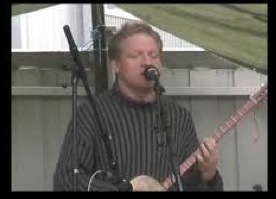

Morten Abildsnes
The artists presented are:
Ayas Danzyryn 1976–2005
Timur Kara-sal 1973–2005
Mönggün-ool Dambashtai 1956–2009
Aleksandr Sarzhat-ool 1957–2011
Aldyn-ool Sevek 1962–2011
Kongar-ool Ondar 1962–2013
Vladimir Oidupaa 1949–2013
Oktyabr Saaya 1968–2012
The internet-streaming can be heard here
http://radionova.no/programmer/sortkanal
To listen to the program find the black-and-grey player box with the title “Repriser” on the same page, and click the line with the text “Sort Kanal 02.02.2015”. On a narrow screen, you might need to scroll further down the page to find the “Repriser” player. On a broad screen, it might lie right under the black-red-black box. On this page you can find the playlist.
2. EPIC THROAT SINGING FROM KHAKASSIA
The Dutch program is by Russian-Dutch producer, field-recordist, DJ Maxim Chapochnikov from Amsterdam, founder of Window to Europe. He first travelled to South-Siberia in the early 1990s. On one of his trips he met Slava Kuchenov, who had just received a calling from the spirit of khaidzhi, or epic story-tellers/reciters. Without any further experience or help, Kuchenov build himself an instrument and started reciting ancient stories about Khakass heroes. Kuchenov is and was a very clear case of a young man who does not set out to learn epic singing, but who receives a divine gift to tell epic stories. They just appeared to him, without first learning them by heart, like dreams appear to us. Maksim was there to capture this gift on mic right when it happened (of course Kuchenov still recites epics nowadays). Maksim presents a large part of the original recording in his radioshow. After a Dutch introduction you can hear almost one hour of Khakass epic throat singing. To listen, click on the link below, then click on the small loudspeaker to the right of the words “22:00 – 23:00 De Zwervende Microfoon”.![]()
![]()
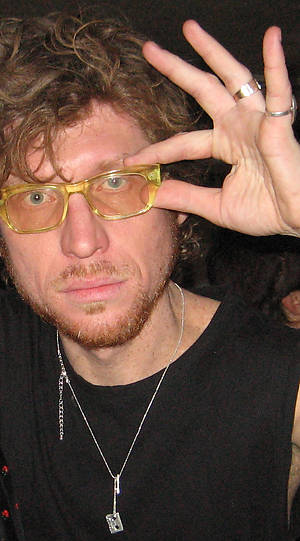

Maksim Chapochnikov (photo by Mediamatic)
Thanks to Maxim and Morten for sharing these recordings from their collections! Enjoy listening!
Featured image: Slava Kuchenov at the rock formations of Salbyk, Khakassiya. Photo: Mark van Tongeren 2005
Five reasons for remembering Michael Vetter
Today, December 7, 2014, it is one year ago since the German artist Michael Vetter passed away, shortly after turning 70. Several musical events commemorate the passing away of this visionary artist, who is best known as an overtone singer. Three weeks ago we had a Festival Transverbal here in Taipei, the German radio repeated DuO, a fantastic radio play by Michael Vetter and Natascha Nikeprelevic from 1997, and there will be a reprise of his Missa di Natale (1998) by his former students of the Diaphonisches Vokalensemble in Cologne (see links at end of the posting). But Michael Vetter did much more than making music, and here I will put his creative life and his critical mind in a wider perspective than is usually done.
1. An outstanding and extremely productive visual artist
After spending many years of his youth already drawing and painting seriously, Vetter developed an extraordinary visual language of his own during the 1960s and 1970s, He used a wide range of techniques, from China ink drawings, paintings, watercolours and linocuts to ‘writing pieces’, perhaps his most far-fetching concept. Just like in music, Vetter was completely self-taught as a visual artist. Though he did of course absorb current techniques and styles, he drew much inspiration from Mediaeval techniques – a quite unfashionable source for artists in that period. His passion for great masters of the past was such, that as a teenager he already began collecting original Mediaeval volumes, which he apparently used as source material for his own techniques (he also kept hundreds of art books at home in recent years). If you ever heard Vetter talk about art – or read about his work in his own words – you know that his work was fully developed on a conceptual level: he was acutely aware of the peculiarities of all the major periods and styles in Western art of the second millennium, even of many artists and their development.
2. Laying the basis of Western/contemporary overtone singing
Of course, overtone singing would not look the same if Vetter had not helped to define its modern, Western style. He educated dozens of students that became singers in their own right (some of them well-known), and inspired many more – in fact he blew away many listeners, who had never heard such things before, including myself. Again, Vetter did not just perform a trick, or ‘just make sounds’, like many overtone singers are tempted to do. His melodic-harmonic approach to overtones betrays deeper connections, like with his great example Johann-Sebastian Bach. Few overtone singers are able to achieve such clarity of tone and such variety in the development of their compositions / improvisations as Vetter did. Besides setting an example with his NG-RR techniques (for singing lower and higher overtones, respectively), he produced extensive learning materials for his students and developed at least one unique way of singing overtones I never heard anyone do.
3. Beyond zen
Zen is too fashionable these days. You encounter the most obtuse uses of the word ‘zen’ in attempts to brand something as ‘spiritual’, ‘Asian’ and ‘cool’. Fortunately many people have also had genuine, first-hand zen experiences, among whom many artists. I think overall the transference of zen ideas to the West has led to some great artistic innovations. John Cage’s classes with the zen teacher Daisetz Teitaro Suzuki at Columbia University in the 1940s had far-reaching effects in every imaginable artistic discipline, well beyond the confines of his work as a composer. But Cage never sat cross-legged nor did he learn to meditate. Philip Glass, another big-name twentieth century composer who professed being influenced by Buddhism, did not have the kind of in-depth experiences that traditional students of Buddhism have. Vetter is one of few composers/musicians/artists who did go through the process more thoroughly. He observed daily morning meditations at his master’s shrine when he visited him, several months a year, while dedicating most his time to his own artistic work. He also spend several months a year at a monastery, where he took part in all the rituals, chanting, dressing up, begging for alms, et cetera.
For that reason, and for his superb grasp of art and aesthetics as a whole, I have high regard for the way he appropriated zen performing/visual art for his own artistic means. One of his best ideas is to transform the zen garden into a play, a dynamic process of moving and placing stones and other objects in an open-air surface. Another is his transformation of the okyo, the zen sutra’s. I will not go into those transformations here. Suffice it to say that the changes he made to these two zen traditions were well-informed, and in a way so much in tune with zen thought and practice, that they appear to be a logical step beyond traditional zen (as far as the overtone singing goes, monks disapproved when Vetter would slightly change the sound of his own okyos to amply certain harmonics).
4. ‘The book of signs’: a 40+-year disciplined effort
Since 1972 or 1973 until his death, Vetter spent some time almost every day to work on a Magnus Opus of unusual breath: ‘Das Buch der Zeichen’ / ‘The Book of Signs’ (and that’s more than 40 years). In quick, improvised strokes, he would produce about 15-150 small China ink drawings. At the times I spend with him, he would do this after lunch. He carefully observed how the ink would flow, but as he continued to pull his brush across the paper, the ink would usually continue to flow. This would leave the final result undetermined by the time of his painting. He would continue to produce one drawing after another, mostly abstract, and pile them up while still wet. Then after 30 minutes or so, he would go through all the drawings one by one, carefully observing how the ink had settled. Like in some of his other work, it was his way of letting movement express itself, as it were, flowing through his hands not according to predetermined designs, but as an inevitable result of time unfolding. Each drawing is like a testimony of the flow of time expressed through spontaneous hand movements. I do it myself from time to time, like here, for example, as an ode to Michael. But I realised a few years ago, that if there is one thing I would wish I had (or could develop still), it was Michael’s discipline.
5. humour
O yes, you could have great laughs with Michael. He was full of wit, full of stories of his own adventures, of poems he could recite by heart (and certainly not the romantic ones, but absurd and perplexing ones). He had this mix of seriousness with lightness, bringing everything in balance again after the mind-boggling, or physically-straining or emotionally-charged practicing was done. In his work there were always these unexpected twists, which sometimes turned out very funny. He once told me a story of an invitation to an annual congress of recorder players. Vetter first made his name as an avant-garde recorder player, who completely redefined the instrument in the 1960s. Some of the greatest composers of our time wrote new pieces for him in the 1960s. But when Vetter was heralded as the former avant-garde innovator at the European Recorder Festival in 2006, he noticed that all the vigor had gone. The new generation of students played the radical works of the 1960s almost like classical pieces. What had been thrilling and upsetting 40 years earlier, now sounded tame. Vetter himself played one of J.S. Bach’s violin sonata’s on his recorder at the festival, but not without making the necessary adjustments in timing and phrasing, due to the transference of the piece from violin to recorded. This shocked many a conservative lover of Bach music, so much so, that just like in the 1960s, people left the concert hall, some of them protesting loudly. He recalled this episode with much enjoyment, and though it is not a typical example of Vetter’s humor as such, I treasure those moments when he would tell of all the strange and funny moments in his carreer – or simply tell a joke.
Find the links to the events here:
listen here to the radio-play DuO (click on the photo; introduction in German)



